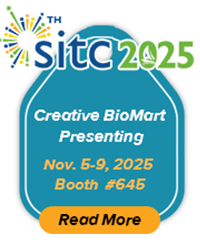AGER
-
Official Full Name
advanced glycosylation end product-specific receptor -
Overview
The advanced glycosylation end product (AGE) receptor encoded by this gene is a member of the immunoglobulin superfamily of cell surface receptors. It is a multiligand receptor, and besides AGE, interacts with other molecules implicated in homeostasis, development, and inflammation, and certain diseases, such as diabetes and Alzheimers disease. Many alternatively spliced transcript variants encoding different isoforms, as well as non-protein-coding variants, have been described for this gene (PMID:18089847). [provided by RefSeq, May 2011] -
Synonyms
AGER;advanced glycosylation end product-specific receptor;RAGE;RAGE isoform sRAGE-delta;RAGE isoform NtRAGE-delta;receptor for advanced glycation end-products variant 20
Recombinant Proteins
- Human
- Mouse
- Rat
- Canine
- Cynomolgus
- Rhesus macaque
- HEK293
- E.coli
- Mammalian Cells
- C-His
- Wheat Germ
- Human Cells
- Fc
- His
- GST
- Non
- Flag
- T7
- Avi
- rFc
Involved Pathway
AGER involved in several pathways and played different roles in them. We selected most pathways AGER participated on our site, such as AGE/RAGE pathway,Activated TLR4 signalling,Advanced glycosylation endproduct receptor signaling, which may be useful for your reference. Also, other proteins which involved in the same pathway with AGER were listed below. Creative BioMart supplied nearly all the proteins listed, you can search them on our site.
| Pathway Name | Pathway Related Protein |
|---|---|
| Activated TLR4 signalling | JUN,MAPK14,S100A12,TLR6,S100B,PELI3,DUSP3B,IRAK3,PELI2,SIGIRR |
| Immune System | IFIT14,CD207,PPAPDC1A,FCN1,TRIM69,CD200R4,ARIH2,DUSP3B,IFIT2,ASB9 |
| MyD88 cascade initiated on plasma membrane | PELI1,S100B,DUSP3B,PELI2,PELI3,TNIP2,TLR10,ALCAMB,CHST13,DHX9 |
| Cytosolic sensors of pathogen-associated DNA | NLRP4B,RIPK3,LRRFIP1,SAA1,POLR3F,NLRP4C,IFI16,NLRP4E,NLRP4,APPA |
| Innate Immune System | CLEC5A,TREM1,CASP4,TRIM56,ABI1,IRF2,DDX41,PANX1B,SIGLEC15,BTR18 |
| AGE/RAGE pathway | JUN,TIRAP,LGALS3,MAPK14,EGFR,JAK2,MMP13,DIAPH1,ATF2,DDOST |
| Advanced glycosylation endproduct receptor signaling | ALCAMB,APPA,APPB,DDOST,SAA1,S100A12,LGALS3,S100B |
| DEx/H-box helicases activate type I IFN and inflammatory cytokines production | APPB,S100B,CHST13,SAA1,ALCAMB,S100A12,DHX9,APPA |
Protein Function
AGER has several biochemical functions, for example, S100 protein binding,advanced glycation end-product receptor activity,high mobility group box 1 binding. Some of the functions are cooperated with other proteins, some of the functions could acted by AGER itself. We selected most functions AGER had, and list some proteins which have the same functions with AGER. You can find most of the proteins on our site.
| Function | Related Protein |
|---|---|
| protein binding | RHOB,EMG1,TRAPPC10,OSBPL1A,PXN,ICA1L,MAGEA1,C1orf105,MET,ARL4C |
| transmembrane signaling receptor activity | CD300C,PTH1RA,Cd79a,THBD,TNFRSF11A,HIST2H3C2,GHRHRA,SORL1,GHRHR2,KLRC1 |
| identical protein binding | RUVBL2,FUS,SMURF2,ASS1,VWA1,SLK,DACT3,GPR50,ATG16L1,ROBO1 |
| receptor activity | ATP6AP2,NLGN4Y,XPR1,LILRA3,NLGN2A,NLGN3A,VAC14,TMEM123,PVRL3B,CSF2RB |
| S100 protein binding | ATP2A2,KCNK3,FGF1,AHNAK,ANXA2,ANXA11,S100A11,S100B,S100A6,EZR |
Interacting Protein
AGER has direct interactions with proteins and molecules. Those interactions were detected by several methods such as yeast two hybrid, co-IP, pull-down and so on. We selected proteins and molecules interacted with AGER here. Most of them are supplied by our site. Hope this information will be useful for your research of AGER.
S100B;DIAPH1;TTR;GRB2;Diaph1;HMGB1;S100A1
Resources
Related Services
Related Products
References
- Lindskog, C; Fagerberg, L; et al. The lung-specific proteome defined by integration of transcriptomics and antibody-based profiling. FASEB JOURNAL 28:5184-5196(2014).
- Potzsch, S; Blankenhorn, A; et al. The effect of an AGE-rich dietary extract on the activation of NF-kappa B depends on the cell model used. FOOD & FUNCTION 4:1023-1031(2013).




